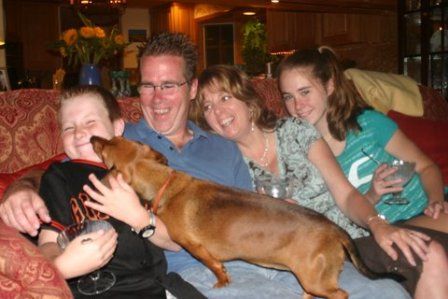Article
When myeloma awareness goes mobile
Author(s):

Michael and I lived a traditional American lifestyle: he worked full time in the manufacturing industry while I stayed at home to raise our two young children. Our youngest was just two years old when Michael began experiencing serious back pain. We never imagined that the symptoms would mark the beginning of Michael's lifelong battle against cancer.In 2000, at the age of 36, Michael was diagnosed with multiple myeloma, a cancer of cells in the bone marrow that affects production of red cells, white cells and stem cells, and can damage bone. Myeloma is also a cancer--as he was told by doctors--for which there was no cause or cure, and which had on average a five-year survival rate.A five-year survival rate? When we heard that, our first thoughts were for our children. Mikey was barely walking and Allison was only seven years old. We were devastated, but Michael was not willing to accept the idea that he wouldn't be there to watch them grow up.Thirteen years later, Michel, the kids and I look back with gratitude that my stubborn husband refused to believe the doctors' prognosis. Allison is now a sophomore in college and just turned 20, and Mikey is already in high school. We are defying the odds 13 years later, and none of us takes a millisecond of life for granted. One of the ways we show our gratitude is by taking every opportunity to share what we've learned to help others who are struggling with the disease. Educating patients and doctors about myeloma, a disease that is growing in numbers and affecting increasingly younger people, has become our mission--particularly during March, which is Myeloma Awareness Month. Like most patients at the time of diagnosis, neither Michael nor I had ever heard of myeloma. Fortunately, the International Myeloma Foundation (IMF) was there to help us find expert doctors and learn about the latest treatments and clinical trials of new drugs. The IMF also inspired us to reach out to others in our community who were struggling with myeloma and establish the first myeloma support group in our home state of Connecticut. Today we enjoy hosting monthly meetings with our fellow myeloma patients and caregivers--learning, sharing and celebrating our personal milestones as a group. There have been some very scary moments since myeloma entered our lives. After an operation left Michael paralyzed for two months, he needed to re-learn to stand, walk and perform routine things again as simple as putting on his socks and shoes each morning, and was forced to stop working. I cannot tell you how much I admire his strength. He never gave up, and when the time came, he was able to recover enough to help coach Mikey's baseball team.Though it was Michael who had to suffer through the radiation treatment to shrink a large plasma cell tumor that had destroyed two-thirds of his sacrum, a successful stem cell transplant, and an operation that resulted in irreparable nerve damage in both his legs--we faced the successes and setbacks together as a family.Then--as is frequently the case with myeloma patients--Michael's disease returned. This time, after much debate, his doctors at New York-Presbyterian Hospital/Weill Cornell Medical Center settled on a course of treatment (a combination of Revlimid and dexamethasone) that worked. By 2006, Michael had attained complete remission. In the summer of 2007, our family embarked on an educational outreach project called the Myeloma Mobile. With Mikey, Allison and the dog and cat in tow, our family traveled across the country, covering over 12,000 miles, and shared our knowledge and experiences with other patients searching for help and hope. It was an eye-opening experience, not to mention a wonderful time of togetherness. Have you ever parallel-parked a 35-foot RV? I have.For the past several months, Michael and I have been actively involved with the IMF's Myeloma Awareness Month outreach programs. Our hometown of Prospect has officially declared March as Myeloma Awareness Month along with more than 40 cities and towns; six counties; three states and the entire country of Barbados that have issued similar proclamations. (Barbados? Maybe we'd better go investigate!)The future for myeloma patients doesn't look nearly as bleak as it did when Michael was first diagnosed. In the past 10 years, the Food and Drug Administration has approved eight new treatment therapies for multiple myeloma. People are living longer and with better quality of life with the disease. Michael is an example of that. Our family leads an active life and we are encouraged that his remission will last a long time. In fact, Michael is also a musician and he wrote a song for our children entitled "I'm Not Leaving." I think that pretty much says it all, doesn't it? Robin Tuohy lives in Connecticut and is Senior Director of Support Groups for the International Myeloma Foundation. Before that, she worked as a paralegal for over 10 years at a Fortune 500 company. She and her husband Michael have been married for 23 years and "face all that life brings us together--both the blessings and the challenges."




